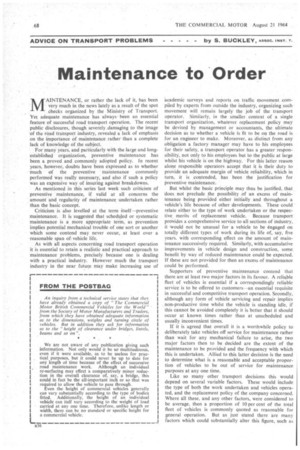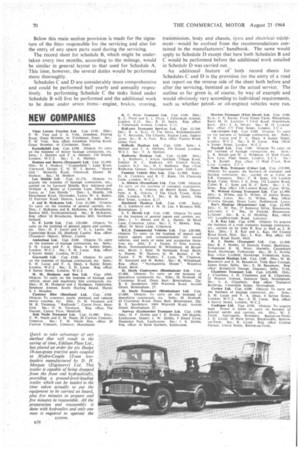Maintenanceto Order
Page 72

Page 73

Page 74

If you've noticed an error in this article please click here to report it so we can fix it.
MAINTENANCE, or rather the lack of it, has been very much in the-news lately as a result of the spot checks organized by the Ministry of Transport. Yet adequate maintenance has alwaysbeen an essential feature of successful road transport operation. The recent public disclosures, though severely damaging to the image of the road transport industry, revealed a lack of emphasis on the importance of maintenance rather than a complete lack of knowledge of the subject.
For many years, and particularly with the large and longestablished organization, preventive maintenance has been a proved and commonly adopted policy. In recent years, however, doubts have been expressed as to whether much of the preventive Maintenance commonly performed was really necessary, and also if such a policy was an expensive way of insuring against breakdowns.
As mentioned in this series last week such criticism of preventive maintenance, if valid at all concerns the amount and regularity of maintenance undertaken rather than the basic concept.
Criticism is also levelled at the term itself—preventive maintenance. It is suggested that scheduled or systematic maintenance is a more appropriate term, as prevention implies potential mechanical trouble of one sort or another • which some contend may never occur, at least over a reasonable span of vehicle life.
As with all aspects concerning road transport operation it is essential to retain a realistic and practical approach to maintenance problems, precisely because one is dealing with a practical industry. However much the transport industry in the near future may make increasing use of
academic surveys and reports on traffic movement compiled by experts from outside the industry, organizing such movement will remain largely the job of the transport operator. Similarly, in the smaller, context of a single transport organization, whatever replacement policy may be devised by management or accountants, the ultimate decision as to whether a vehicle is fit to be on the road is for an engineer to make. Moreover, as distinct from any obligation a factory manager may have to his employees for their safety, a transport operator has a greater responsibility, not only to his employees but to the public at large whilst his vehicle is on the highway. For this latter reason alone responsible operators accept that it is their duty to provide an adequate margin of vehicle reliability, which in turn, it is contended, has been the justification for preventive maintenance. •
But, whilst the basic principle may thus be justified, that does not preclude he possibility of an excess of maintenance being provided either initially and throughout a vehicle's life because of other developments. These•could relate either to the type of work undertaken or the respective merits of replacement vehicle. Because transport provides a comprehensive service to all sections of industry, it would not be unusual for a vehicle to be engaged on totally different types of work during its life of, say, five years. with corresponding effect on the amount of maintenance successively required. Similarly, with accumulative improvements in vehicle design and construction, some benefit by way of reduced maintenance could be expected. If these are not provided for then an excess of maintenance could be performed.
Supporters of preventive maintenance contend that there are at least two major factors in its favour. A reliable fleet of vehicles is essential if a correspondingly reliable service is to be offered to customers—an essential requisite in successful and competitive transport operation. Secondly, although any form of vehicle servicing and repair implies non-productive time whilst the vehicle is standing idle, if this cannot be avoided completely it is better that it should occur at known times rather than at unscheduled and usually inconvenient times.
If it is agreed that overall it is a worthwhile policy to deliberately take vehicles off service for maintenance rather than wait for any mechanical failure to arise, the two major factors then to be decided are the extent of the maintenance to be provided and the frequency with which this is undertaken. Allied to this latter decision is the need to determine what is a reasonable and acceptable proportion of vehicles to be out of service for maintenance purposes at any one time.
Like so many other transport decisions this would depend on several variable factors. These would include the type of both the work undertaken and vehicles operated, and the replacement policy of the company concerned. Where all these, and any other factors, were considered to be average, then a proportion of 10 per cent of the total fleet of vehicles is commonly quoted as reasonable for general operation. But as just stated there are many factors which could substantially alter this figure, such as the availability of facilities for overnight or week-end maintenance.
In this context Table 35 of the Survey of Road Goods Transport, 1962, Final Results, Part I, is apposite. Under 24 standard industrial classifications it analyses the number of C-licensed vehicles idle during the survey weeks in 1962, with the reasons for idleness being provided as between repairs, holidays and no work. The figures given are the averages for the four survey weeks. The following are examples from the larger industrial groups.
The total number of C-licensed vehicles analysed in the survey was approximately Of these, 540,300 vehicles were grouped under distributive trades and of this latter amount 51,700 were recorded as idle ". In the construction group 23.900 of the total of 190,700 were idle, a somewhat higher percentage. Under the heading " Transport and Communication ", 3,100 vehicles out of a total of 14,200 were reported as idle during the survey period, approximately 22 per cent.
Without knowledge of the actual work undertaken these figures could be misleading. Thus the high percentage in the latter category could well result from the fact that C-licensed vehicles attached to transport undertakings are there to provide a service in the event of breakdown rather than to carry goods. Their very availability (as with a fire engine), even if not actually used, must be considered part and parcel of the service and the price to be paid for it.
More recently Volume 1 of the London Traffic Survey has been published, and in the summary of principal findings and general conclusions the following comment is made on goods vehicle travel. About 83 per cent of the 191,000 goods vehicles based in the survey area made journeys on a typical weekday in 1962. As a substantial proportion of the total are small vans it is conceivable that when applied to heavier goods vehicles the percentage of vehicles as shown here as not in use—namely, 17 per cent— will be substantially reduced and probably come within measurable difference of the overall figure of 12 per cent for C-licensed vehicles recorded in the Survey of Road Goods Transport.
• It is therefore established that whatever the system and extent of maintenance, an appreciable proportion—around 10 per cent--is off the road at any one time for maintenance or other reasons. It is an advantage of preventive maintenance that by proper scheduling of repair work some of the other reasons—for example drivers' holidays and lack of work because of seasonal fluctuations—can be arranged to coincide with maintenance work.
Assuming an operator intends inaugurating a preventive maintenance system it will first be necessary to determine whether the type of work and types of vehicles are so dissimilar as to require two or more separate groups within the overall system. This, in fact, would be unusual and where variations do exist usually these can be accommodated by adjustments in the mileage interval between successive spells of maintenance, A more common variation will be as between different makes of vehicles in the same fleet. In recent years manufacturers' handbooks on the maintenance of their vehicles have improved considerably and have become more comprehensive. Although basically many of these are similar in their requirements, particularly as much proprietary equipment is common to most makes, nevertheless there are some differences. It is therefore necessary for individual operators to draw up a compromise schedule of maintenance applicable to all makes so as to avoid undue complication to little advantage by meticulous attention to every specific requirement in the several handbooks.
The common feature of most preventive maintenance schemes drawn up on the basis of manufacturers' hand books is to arrange for, say, three or four schedules of maintenance tasks of increasing comprehensiveness. Because of the wide variation in types of operation it is not possible to recommend standard periods of maintenance, but as an example the first schedule in a fourschedule scheme (which for reference could be termed Schedule A) might conveniently be undertaken fortnightly. Both to ensure that the work has been done and in the operator's interest in the event of a complaint of lack of maintenance, it is advisable to provide suitable record sheets as part of the system. For reasons of economy these could be duplicated if necessary and at the top would be entered the vehicle number, date of service and current mileometer reading.
The main section on this sheet consists of three vertical columns. The first will itemize the several services undertaken and will be already typed on the duplicated sheet. Immediately alongside this first column of service items, space is provided to enter a tick or initial indicating that the work has been done, whilst a larger column allows for entry of reports as to any defects found. Below this main section provision is made for the signature of the fitter responsible for the servicing and also for the entry of any spare parts used during the servicing.
The record sheet for schedule B, which might be undertaken every two months, according to the mileage, would be similar in general layout to that used for Schedule A. This time, however, the several duties would be performed more thoroughly.
Schedules C and D are considerably more comprehensive and could be performed half yearly and annually respectively. In performing Schedule C the tasks listed under Schedule B will first be performed and the additional work to be done under seven items—engine, brakes. steering, • transinission, body and chassis, tyres and electrical equip ment—would be evolved from the recommendations contained in the manufacturers' handbook. The same would apply to Schedule D except that here both Schedules B and C would be performed before the additional work entailed in Schedule D was carried out.
An additional feature of' both record sheets for Schedules C and D is the provision for the entry of a road test report on the reverse side of the.sheet both before and after .the servicing, itemized as for the actual service. The outline so far given is, of course, by way of example and would obviously vary according to individual requirements, such as whether petrol-. or oil-engincd vehicles were run.






















































































































